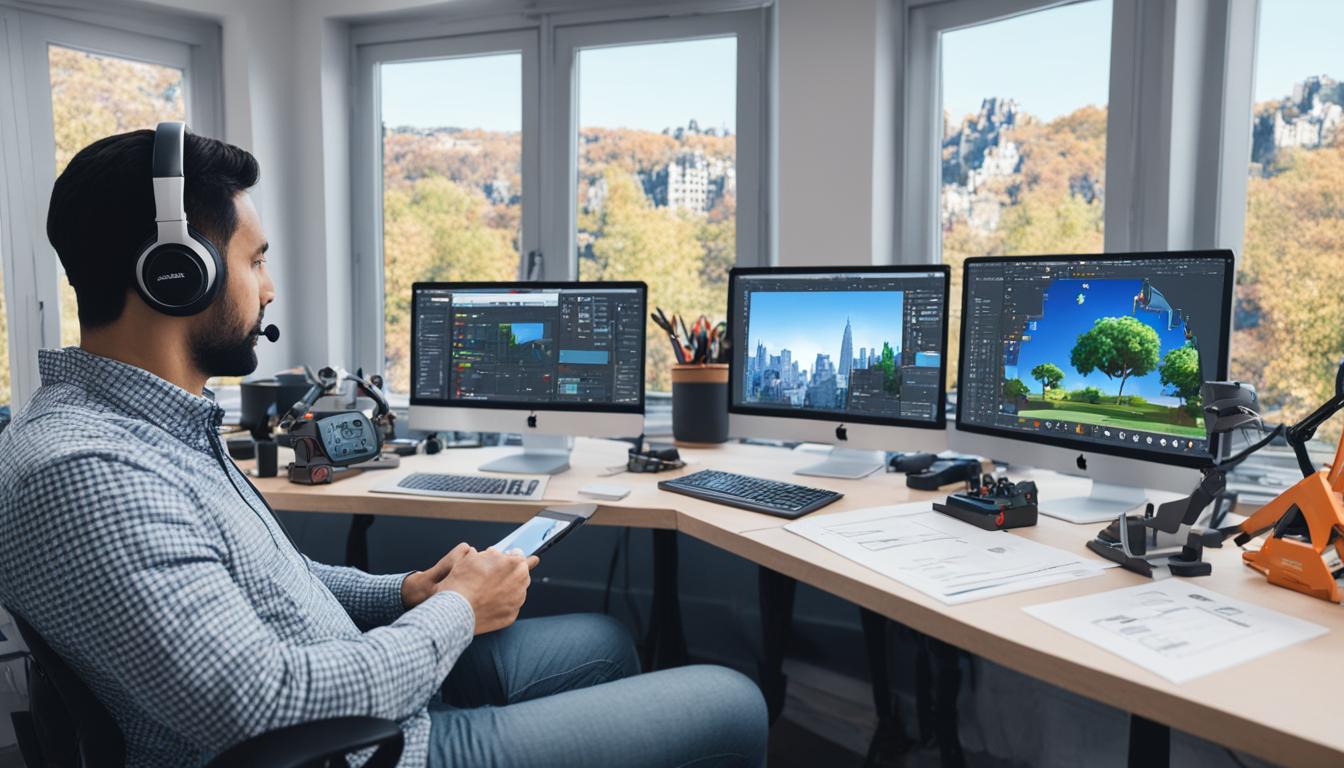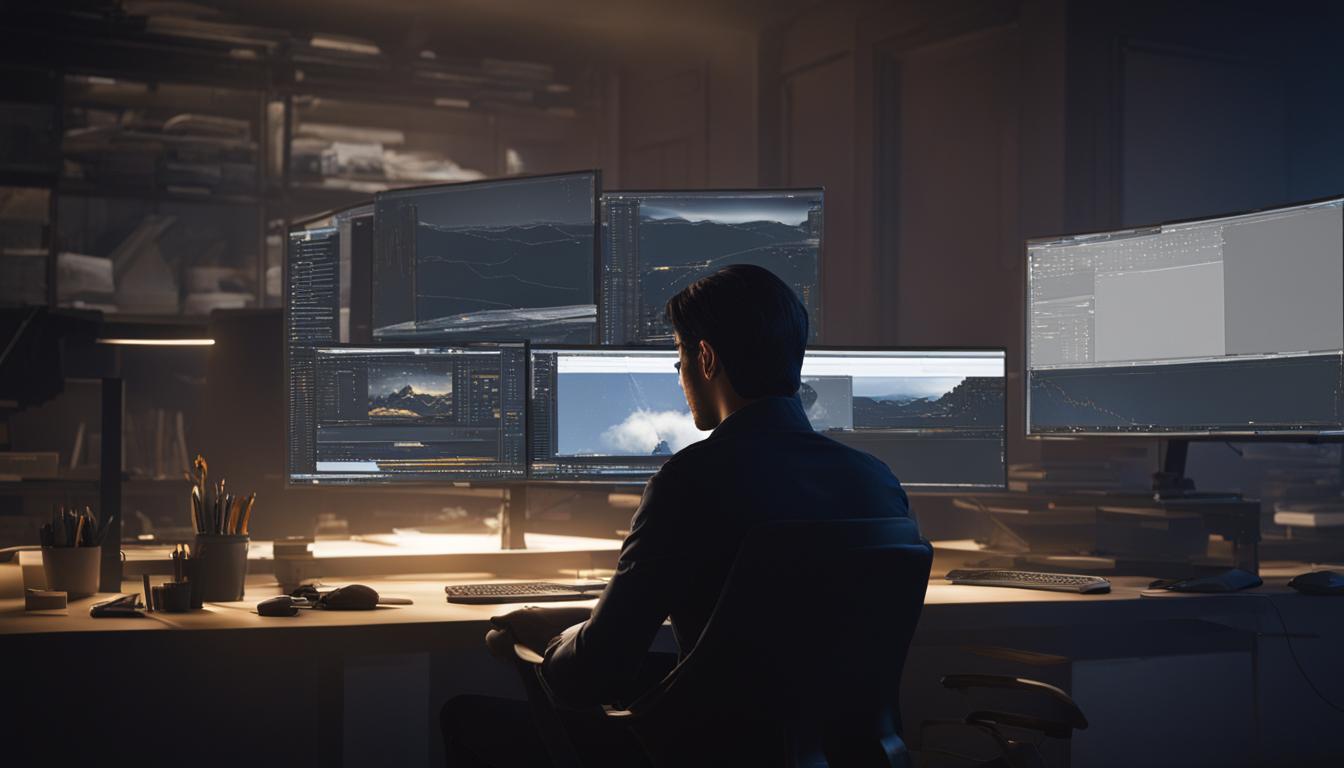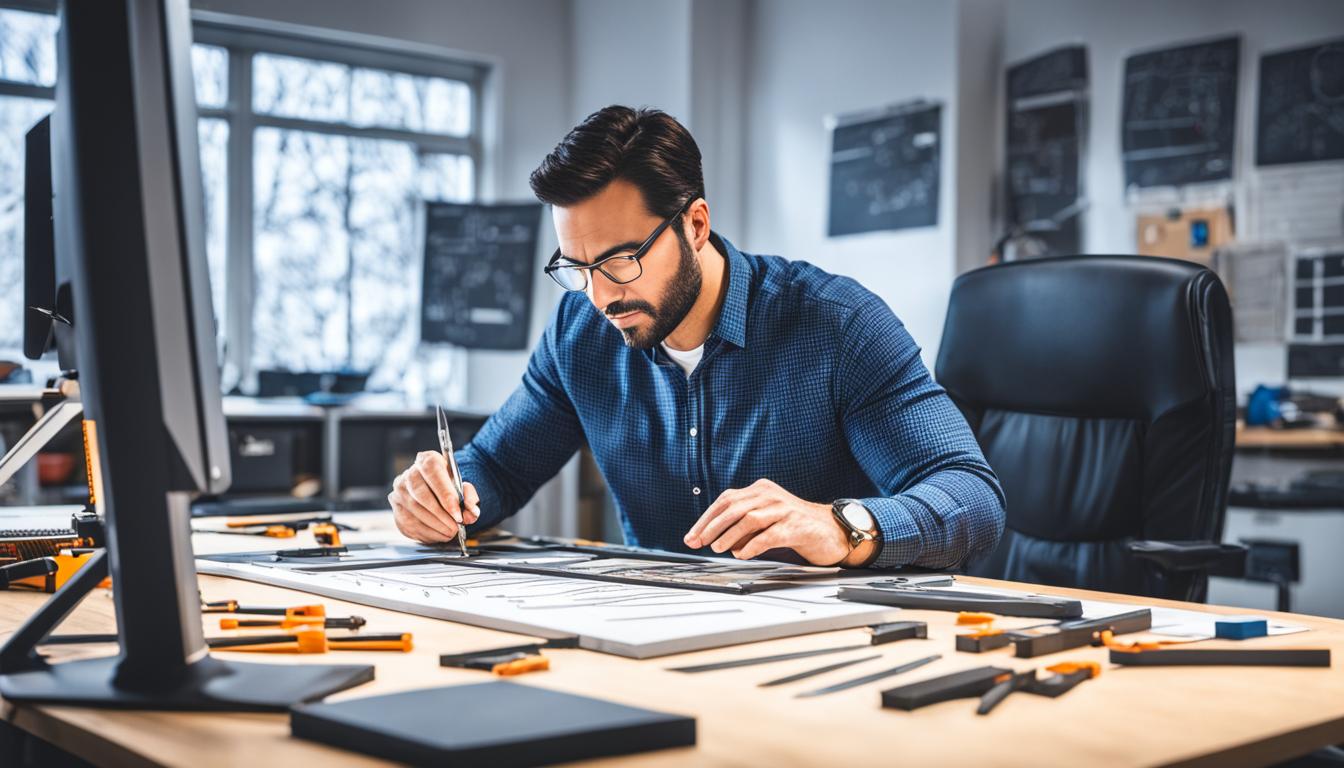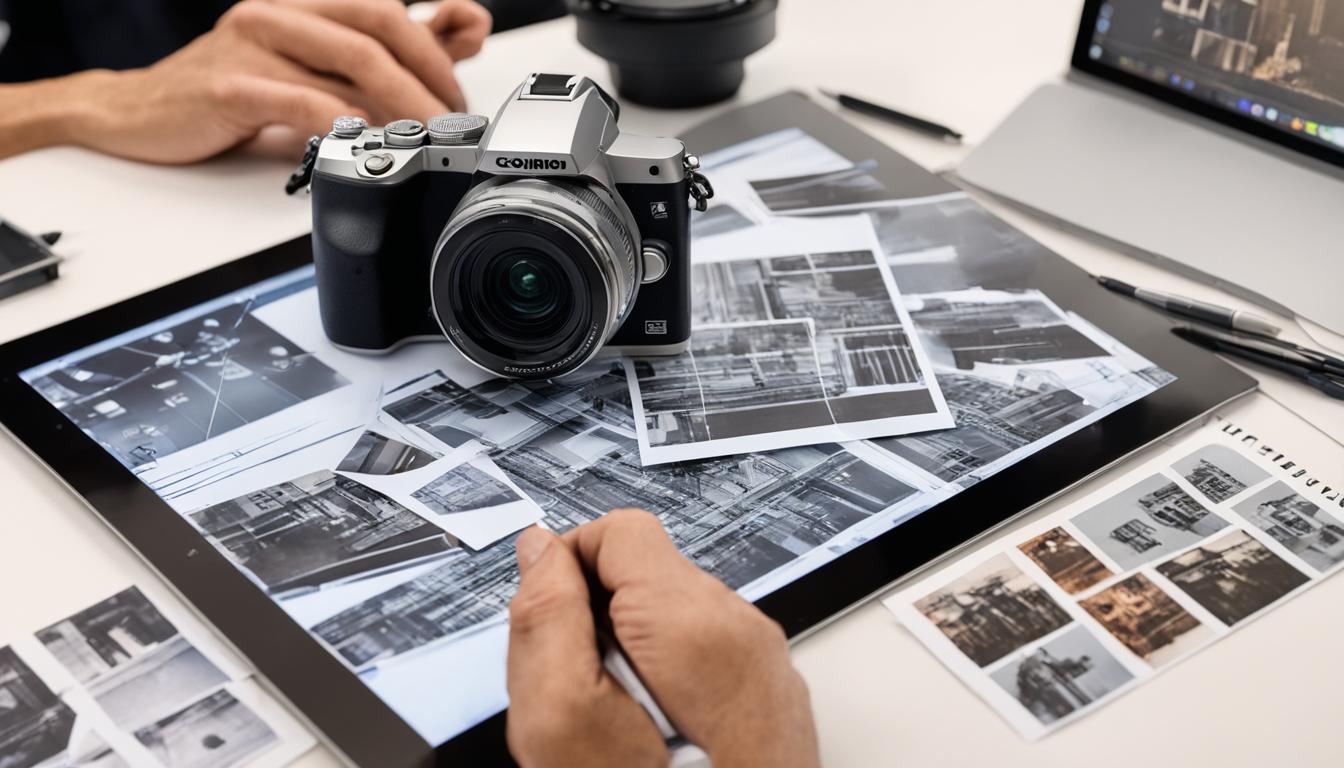Creating 3D models from photos involves a series of steps that combine photography, software processing, and 3D modeling techniques. To begin, capture multiple high-quality images of the subject from various angles, ensuring consistent lighting and minimal background distractions. Next, import these photos into specialized photogrammetry software such as Agisoft Metashape, RealityCapture, or Meshroom, which use algorithms to analyze the images and generate a point cloud.
The software then creates a mesh from this point cloud, forming the basic structure of the 3D model. After mesh creation, the software applies textures derived from the original photos to add color and detail to the model. For more complex subjects, manual refinement may be necessary using 3D modeling software like Blender or Maya to clean up artifacts, add missing details, or optimize the model for specific uses.
Export the completed 3D model in a suitable format for your intended application, whether it’s 3D printing, game development, or virtual reality experiences. This process allows for the transformation of real-world objects into digital 3D assets, bridging the gap between physical and virtual realms in various industries and creative fields.
- Learn how to convert 2D photos into immersive 3D models.
- Get step-by-step guidance on the crafting process.
- Discover the tools and techniques used for creating high-quality 3D models.
- Understand the importance of proper data preparation and model customization.
- Explore the potential applications and future developments in AI-powered 3D modeling.
Why Wonder3D is Your Gateway to Photo-Based 3D Modeling
Wonder3D is a revolutionary cross-domain diffusion model that has completely transformed the process of 3D reconstruction from a single image. With Wonder3D, you have the power to convert your 2D photos into highly detailed 3D models, using the cutting-edge capabilities of artificial intelligence.
One of the key advantages of Wonder3D is its user-friendly interface, designed to accommodate both professionals and enthusiasts. Whether you are a seasoned 3D modeling expert or a beginner taking your first steps in the world of 3D modeling, Wonder3D provides an accessible platform to bring your ideas to life. No matter your skill level, Wonder3D empowers you to explore the possibilities of photo-based 3D modeling and unleash your creativity.
By leveraging Wonder3D’s state-of-the-art AI algorithms, you can embark on a seamless 3D modeling journey. The software is equipped with advanced image analysis techniques, enabling accurate reconstruction of intricate details within the photos. Whether you’re capturing the essence of a landmark, preserving a cherished memory, or visualizing your dream project, Wonder3D ensures precision and realism in every 3D model you create.
Wonder3D’s capabilities extend beyond the standard 3D modeling process. With its intuitive workflow, you can effortlessly navigate through the steps of the 3D modeling tutorial, allowing you to grasp the entire process from start to finish. From importing your photos to refining the final 3D model, Wonder3D offers a comprehensive and streamlined experience.
With Wonder3D as your guide, you can push the boundaries of creativity and embark on exciting 3D modeling projects. Whether you are creating 3D models for entertainment, architectural design, or scientific research, Wonder3D empowers you to transform your ideas into reality.
Setting Up Your Environment for 3D Reconstruction with Wonder3D
Before embarking on the exciting journey of 3D reconstruction, it is crucial to set up your development environment properly. Follow these steps to ensure a smooth and efficient workflow:
Cloning the Wonder3D Repository
The first step is to clone the Wonder3D repository to your local machine. Wonder3D is an innovative software that empowers you to transform 2D images into stunning 3D models. By cloning the repository, you gain access to the source code and essential files needed for the reconstruction process.
Installing Dependencies
Next, you need to install the necessary dependencies to run Wonder3D successfully. These dependencies are libraries or software components that Wonder3D relies on. By installing them, you ensure that Wonder3D has all the tools and resources it needs to generate high-quality 3D models from your images.
Data Preparation
Data preparation is a crucial step in achieving accurate and lifelike 3D models. It involves selecting the right image with the appropriate resolution and lighting conditions. Additionally, performing image pre-processing steps, such as noise reduction or color correction, can significantly improve the accuracy of the final model.
By setting up your environment correctly, you lay the foundation for successful 3D reconstruction using Wonder3D. The following table summarizes the key steps:
| Steps for Setting Up Your Environment |
|---|
| 1. Clone the Wonder3D repository |
| 2. Install the necessary dependencies |
| 3. Prepare your data |
Once you have completed these steps, you are ready to dive into the exciting world of 3D reconstruction using Wonder3D. The next section will guide you through the process of executing the model and understanding its parameters and customization options.

Executing the Model with Wonder3D: Understanding Parameters and Customization
Now that you have set up your environment for 3D reconstruction with Wonder3D, it’s time to dive into executing the model. The process involves understanding the various parameters and customization options available, allowing you to tailor the model to your specific needs. Additionally, it’s crucial to monitor the progress of your model to ensure optimal results.
Understanding Model Parameters
When running the 3D reconstruction model with Wonder3D, you can adjust several parameters to achieve the desired outcome. These parameters include:
- Input Image: Specify the path to the image you want to reconstruct into a 3D model.
- Output Path: Define the destination folder where the generated 3D model will be saved.
- Model Weights: Choose the pre-trained model weights that best suit your project requirements.
- Diffusion Steps: Determine the number of diffusion steps to be performed during the reconstruction process. Adjusting this parameter can influence the level of intricacy and detail in the final 3D model.
By customizing these model parameters, you can optimize the 3D reconstruction process to match your specific use case, whether it’s for architectural visualization, virtual reality experiences, or any other creative project.
Monitoring Progress
Monitoring the progress of your 3D reconstruction model is essential to ensure smooth execution and accurate results. Wonder3D provides comprehensive logs that offer valuable insights into the current diffusion step, estimated time remaining, and any potential errors encountered during the process.
By regularly monitoring the logs, you can identify any issues that may arise and take the necessary measures to address them. This real-time feedback helps you maintain control and make informed decisions to achieve the desired outcome.
Example of Wonder3D Log:
Diffusion Step: 50/100
Estimated Time Remaining: 2 hours 30 minutes
Errors: None
With these insights, you can track the progress of your model and ensure a successful 3D reconstruction process.

Customizing Wonder3D
In addition to adjusting the model parameters, Wonder3D offers customization options to further enhance your 3D models. These options include:
- Texture Mapping: Apply textures to your 3D models to add realism and depth.
- Material Adjustments: Modify the properties of materials applied to your models, such as reflectivity and transparency.
- Lighting Effects: Experiment with different lighting setups to achieve the desired ambiance and visual appeal.
- Rendering Styles: Choose from various rendering styles, such as wireframe, smooth shading, or realistic rendering.
With these customization options, you can unleash your creativity and bring your 3D models to life with stunning visual effects.
Visualizing the Results: Bringing Your 3D Models to Life
Once the 3D model is generated, it’s time to bring it to life through visualization. Wonder3D provides built-in visualization tools that allow you to quickly view and interact with your models. These intuitive tools enable you to explore every angle and detail of your 3D creations, enhancing your understanding and appreciation of the final product.
But the visualization possibilities don’t end there. You can also utilize external tools like MeshLab, a powerful open-source software, to take your visualization to the next level. MeshLab offers advanced features such as mesh smoothing, mesh simplification, and 3D measurement tools, allowing you to refine your models and analyze them with precision.
To further enhance the realism and aesthetics of your 3D models, you can add textures and colors. This can be done using image editing software like Photoshop, where you can paint directly onto the surface of the model or apply pre-designed textures. Additionally, 3D modeling software such as Blender provides a wide range of tools and techniques for creating realistic materials and textures that truly bring your models to life.
Visualizing your 3D models is not only essential for evaluating their quality but also for showcasing your work and capturing the attention of your audience. Whether you’re creating visual content for architecture, product design, or entertainment, the ability to effectively visualize your 3D models adds depth and impact to your presentations.
Take a look at the stunning visualization below, created using Wonder3D and enhanced with textures and colors:
By investing time and effort into visualizing your 3D models, you can communicate your ideas more effectively and capture the essence of your designs. Embrace the power of visualization tools and techniques to unlock the full potential of your 3D creations.
Evaluating and Refining the Quality of Your 3D Models
Evaluating the quality of your 3D models is crucial to ensure their accuracy, precision, and overall appeal. By carefully assessing various factors such as detail preservation, noise detection, and structural integrity, you can refine your models and achieve the desired level of quality and realism.
Detail Preservation
Detail preservation refers to the ability of a 3D model to accurately capture the finer elements present in the original photos. To evaluate this aspect, compare the model with the source images and analyze how well it replicates intricate details such as textures, edges, and surface features. Look for any signs of loss or distortion in these details.
Noise Detection
Noise refers to unwanted artifacts or discrepancies present in a 3D model. It can occur due to various factors such as image noise during data acquisition or inaccuracies in the reconstruction process. To detect noise, examine the model closely for any irregularities, inconsistencies, or unnatural elements that do not align with the original scene. Noise detection is essential for achieving a clean, polished final model.
Structural Integrity
Structural integrity pertains to the overall stability and coherence of the 3D model. It involves evaluating how well the model represents the actual objects or scene it is intended to depict. Look for any structural anomalies, deformations, or inaccuracies that may compromise the model’s authenticity and believability. A structurally sound model should accurately represent the real-world objects it is based on.
Based on your evaluation of the 3D model, you may need to refine and correct any discrepancies to enhance its quality. This can be done through a variety of methods, including adjusting the model parameters in the reconstruction software or employing 3D editing tools for manual refinement.
Refining the model is an iterative process that involves making adjustments, evaluating the changes, and repeating the refinement steps until the desired level of quality is achieved. It requires both technical expertise and an artistic eye for detail.
To further illustrate the importance of evaluating and refining 3D models, consider the following table:
| Quality Evaluation Criteria | Description |
|---|---|
| Detail Preservation | Evaluate the accuracy of captured details such as textures, edges, and surface features. |
| Noise Detection | Identify and eliminate any unwanted artifacts or inconsistencies present in the model. |
| Structural Integrity | Assess the overall stability and coherence of the model, ensuring it accurately represents the real-world objects or scene. |

Best Practices for Creating High-Quality 3D Models
To create high-quality 3D models, it’s important to follow best practices. By implementing these practices, you can ensure that your models are visually stunning and technically sound. Here are some key tips to consider:
- Use High-Resolution Images: Start with high-resolution images to capture finer details and improve the overall image quality. Higher resolution images provide more information for the 3D reconstruction process, resulting in more accurate and realistic models.
- Experiment with Different Images: Don’t be afraid to experiment with different images to observe how the model reacts. Try using images with varying lighting conditions, angles, and perspectives to see how it affects the final 3D model. This experimentation will help you understand the strengths and limitations of the reconstruction process.
- Stay Updated with Advancements: The field of 3D modeling is constantly evolving, with new advancements and improvements being made. Stay updated with the latest research papers, software updates, and techniques to ensure you are utilizing the best methods available. By staying informed, you can incorporate the latest techniques and technologies to enhance your 3D modeling workflow.
By following these best practices, you can elevate the quality of your 3D models and create visually stunning and realistic representations. Remember that practice and experimentation are key to refining your skills and achieving the best results.
Image Quality Matters
The quality of the images used for 3D modeling plays a crucial role in the final output. High-resolution images capture finer details, resulting in more accurate and visually appealing 3D models. When selecting images for your project, prioritize those with good lighting, high resolution, and sharp focus. This will ensure that your models are of the highest quality and meet your expectations.
Advanced Implementations and Applications of Wonder3D
Wonder3D offers a world of possibilities when it comes to advanced implementations and applications. This groundbreaking software can be seamlessly integrated into various industries, opening doors to new creative and technological frontiers. From gaming to augmented reality and simulations, Wonder3D empowers professionals and enthusiasts alike to enhance their projects with immersive 3D models.
Enhancing Realism in Gaming
In the gaming industry, Wonder3D revolutionizes the way developers create realistic game environments. By generating high-quality 3D models from photos, Wonder3D enables game designers to breathe life into their virtual worlds. From character designs to intricate landscapes, Wonder3D empowers developers to create immersive gaming experiences with stunning visual detail.
Immersive Augmented Reality Experiences
Wonder3D takes augmented reality to a whole new level by enabling the creation of immersive experiences. With Wonder3D’s advanced modeling capabilities, developers can transform photos into 3D models that seamlessly blend with the real world. From interactive educational apps to captivating marketing campaigns, Wonder3D opens the door to limitless possibilities in augmented reality.
Driving Simulations and Visualization in Various Industries
Wonder3D finds extensive applications in industries like architecture and entertainment, where simulations and visualizations play a crucial role. By leveraging Wonder3D’s advanced algorithms, professionals can create accurate 3D models that aid in architectural design, structural analysis, and virtual walkthroughs. In the entertainment industry, Wonder3D enables the creation of lifelike animated characters and visually stunning special effects.
Unlocking Creative and Technological Frontiers
Whether it’s pushing the boundaries of gaming, augmenting reality, or delivering realistic simulations, Wonder3D paves the way for advanced implementations. Its user-friendly interface and powerful AI algorithms make it accessible to a wide range of industries and applications. Wonder3D empowers creators and innovators to explore new creative and technological frontiers, unlocking unlimited potential.
| Industry | Application |
|---|---|
| Gaming | Enhancing realism in game environments |
| Augmented Reality | Creating immersive AR experiences |
| Architecture | Aiding in design and visualization |
| Entertainment | Generating lifelike characters and special effects |
The Future of AI-Powered 3D Modeling
The partnership between AI and online tools is shaping the future of design, revolutionizing the way we conceptualize and execute creative projects. With the continuous improvement of algorithms and capabilities, we can anticipate the generation of even more realistic and intricate 3D models from everyday photos. AI-generated 3D models are set to redefine the boundaries of design, offering limitless possibilities for visual content creators and designers.
The evolution of 3D modeling has been greatly accelerated by AI and online tools. These advancements have democratized access to the creation of high-quality 3D models, eliminating the need for extensive technical knowledge and expertise. Designers and creators can now rely on AI-powered software to transform their ideas into tangible and immersive representations.
AI-generated 3D models present exciting opportunities for the future of design. From architecture and product design to gaming and entertainment, the integration of AI and 3D modeling opens doors to new creative frontiers. With the ability to quickly generate detailed and lifelike models, designers can streamline their workflows, iterate faster, and bring their visions to life with unparalleled efficiency.
As the technology continues to advance, we can anticipate further enhancements in AI-generated 3D modeling. This includes improved accuracy, enhanced realism, and expanded capabilities. Designers and creators will have access to a vast array of AI-powered tools, enabling them to push the boundaries of what is possible in visual storytelling, virtual reality, augmented reality, and more.
With the future of 3D modeling being driven by AI, it is essential for designers and creators to stay abreast of the latest advancements and developments in the field. By embracing AI and leveraging online tools, they can stay ahead of the curve and unlock new levels of creativity, efficiency, and innovation.
Key Benefits of AI-Powered 3D Modeling
| Benefits | Description |
|---|---|
| Increased Efficiency | AI-powered 3D modeling streamlines the design process, enabling faster iterations and reducing the time required to bring ideas to fruition. |
| Improved Realism | AI algorithms can generate highly detailed and realistic 3D models, enhancing the immersive experience for viewers and users. |
| Accessibility | AI-powered tools make 3D modeling more accessible to a wider range of designers and creators, eliminating the need for extensive technical skills. |
| Time and Cost Savings | By automating various aspects of the 3D modeling process, AI reduces the time and costs associated with manual modeling and rendering. |
| Innovation and Exploration | AI-generated 3D models encourage creativity and experimentation, allowing designers and creators to explore new design concepts and possibilities. |
As the future of design unfolds, AI-generated 3D models will continue to shape the way we perceive and interact with digital content. With their immense potential and capabilities, AI-powered tools and technologies are set to revolutionize the creative landscape, empowering designers and creators to push the boundaries of imagination and innovation.
Conclusion
With the integration of AI and online tools, transforming photos into captivating 3D models has never been easier. Wonder3D and other AI-powered tools have streamlined the process, allowing designers to create high-quality 3D models from their images with ease. The future of 3D modeling is incredibly promising, with advancements continuously pushing the boundaries of creativity and innovation.
As AI algorithms and capabilities continue to evolve, we can anticipate even more realistic and intricate 3D models generated from everyday photos. This revolution in design opens up a world of possibilities for visual content creators, enabling them to conceptualize and execute their creative projects in ways they could only dream of before.
It’s time to explore the realm of photo-based 3D modeling and unlock your potential. Whether you’re a professional designer or an enthusiastic hobbyist, the accessibility and efficiency of AI-powered tools like Wonder3D empower you to bring your visions to life. Embrace the future of 3D modeling and discover the limitless creative opportunities that await.
